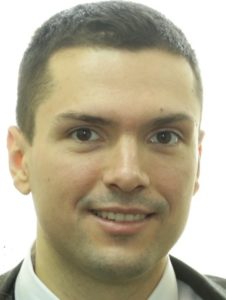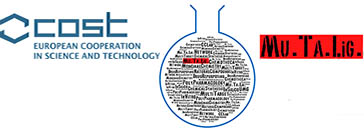
General information
| Name: Vladimir |
| Surname: Dobričić |
| E-mail: vladimir@pharmacy.bg.ac.rs |
| Cell phone number with international prefix: +381665377577 |
| Country: Serbia |
| Affiliation: Department of Pharmaceutical Chemistry, University of Belgrade – Faculty of Pharmacy |
| Gender: F □ M T |
| Year of the PhD title: 2014 |
| Personal web page: https://www.linkedin.com/in/vladimir-dobri%C4%8Di%C4%87-332255ab?trk=hp-identity-name |
| Previous COST participation: No T Yes □ |
List of 10 selected publications within last 5 years
| 1. Janković J, Djekic Lj, Dobričić V, Primorac M. Evaluation of critical formulation parameters in design and differentiation of self-microemulsifying drug delivery systems (SMEDDSs) for oral delivery of acyclovir. Int J Pharm 2016, 497, 301-311 |
| 2. Janićijević J,Krajišnik D, Čalija B, Nedić Vasiljević B, Dobričić V, Daković A, Antonijević MD, Milić J. Modified local diatomite as potential functional drug carrier – a model study for diclofenac sodium. International Journal of Pharmaceutics, 2015 496, 466-474. |
| 3. Dobričić V, Francuski B.M, Jaćević V, Rodić M.V, Vladimirov S, Čudina O, Francuski Dj. Synthesis, crystal structure and local anti-inflammatory activity of L-phenylalanine methyl ester derivative of dexamethasone-derived cortienic acid, Journal of the Serbian Chemical Society, 2015, 80, 1481-1488. |
| 4. Krstić M, Popović M, Dobričić V, Ibrić S. Influence of solid drug delivery system formulation on poorly water-soluble drug dissolution and permeability. Molecules 2015, 20, 14684-14698 |
| 5. Vucicevic J, Nikolic K, Dobričić V, Agbaba D. Prediction of blood – brain barrier permeation of α-adrenergic and imidazoline receptor ligands using PAMPA technique and quantitative-structure permeability relationship analysis. European Journal of Pharmaceutical Sciences 2015, 68, 94-105 |
| 6. Dobričić V, Marković B, Milenković N, Savić V, Jaćević V, Rančić N, Vladimirov S, Čudina O. Design, synthesis and local anti-inflammatory activity of 17b-carboxamide derivatives of glucocorticoids. Archiv der Pharmazie 2014, 347, 786-797 |
| 7. Dobričić V, Nikolic K, Vladimirov S, Čudina O. Biopartitioning micellar chromatography as a predictive tool for skin and corneal permeability of newly synthesized 17b-carboxamide steroids. European Journal of Pharmaceutical Sciences 2014, 56, 105-112 |
| 8. Dobričić V, Marković B, Nikolic K, Vladimirov S, Čudina O. 17b-carboxamide steroids – in vitro prediction of human skin permeability and retention using PAMPA technique. European Journal of Pharmaceutical Sciences 2014, 52, 95-108 |
| 9. Krajišnik D, Daković A, Malenović A, Djekić Lj, Kragović M, Dobričić V, Milić J. An investigation of diclofenac sodium release from cetylpyridinium chloride-modified natural zeolite as a pharmaceutical excipient. Microporous and Mesoporous Materials 2013, 167, 94-101 |
| 10. Markovic B, Dobricic V, Vladimirov S, Cudina O, Savic V, Karljikovic-Rajic K. Investigation of solvolysis kinetics of new synthesized fluocinolone acetonide C-21 esters-an in vitro model for prodrug activation. Molecules 2011, 16, 2568-2671 |
Main skills and expertise (up to 5)
| 1. Drug design (molecular docking and QSAR analysis) |
| 2. Drug synthesis |
| 3. Evaluation of permeability through biological membranes using in vitro techniques |
| 4. HPLC and LC-MS/MS analysis of drug substances and pharmaceutical formulations |
| 5. |
Main equipment/facilities available in the participants’ lab (up to 5)
| 1. Parallel Artificial Membrane Assay (PAMPA) models for the in vitro predicton of permeability of drugs through biological membranes |
| 2. Drug design softwares (ChemBioOffice Pro13, Gaussian09W, Simca 12+P, Dragon 6.0, Pentacle 1.0.6, FLAP 2.0.2 , ADMET Predictor, AutoDock Vina 1.1.2, Gold 5.4.0) |
| 3. Triple quadrupole mass spectrometer with a heated electrospray ionization |
| 4. NMR spectrometer (400 MHz) |
| 5. Electrochemical biosensor (DNA-modified electrodes) for the simulation of interaction of drugs with DNA |
Short personal activity proposal for the COST Action CA15135 (max 1000 characters)
| Main research activities of our group within the CA15135 action will include:
-Design of novel multi-target ligands by use of molecular docking studies, quantitative-structure activity relationship analysis (3D-QSAR), pharmacophore modelling, virtual screening methods (ligand-based and structure-based virtual screening) and in silico ADMET studies;
-Development of novel acridine derivatives with potential antiproliferative activity, based on the dual enzyme inhibition (src and MEK kinases, VEGFR-2 and src kinase);
-Development of novel non-steroidal compounds with potential antiproliferative activity, based on the dual inhibition of aromatase and steroid-sulfatase;
-Application of in vitro PAMPA and biopartitioning micellar chromatography models (developed in our lab) for the assessment of permeability through biological membranes (gastrointestinal tract, skin and blood-brain barrier);
-Development of electrochemical biosensor (DNA-modified electrodes) for the simulation of interaction of drugs with DNA. |
Work Group preference: score from 1 (preferred) to 4 (not preferred)
| Work Group of the CA15135 COST Action | Score |
| WG1: Development of new chemical entities | 1 |
| WG2: Selection of biological targets and assessment of biological data | 4 |
| WG3: Development of chemical databases | 3 |
| WG4: Development of Computational methods for multiple ligand design and discovery | 2 |
